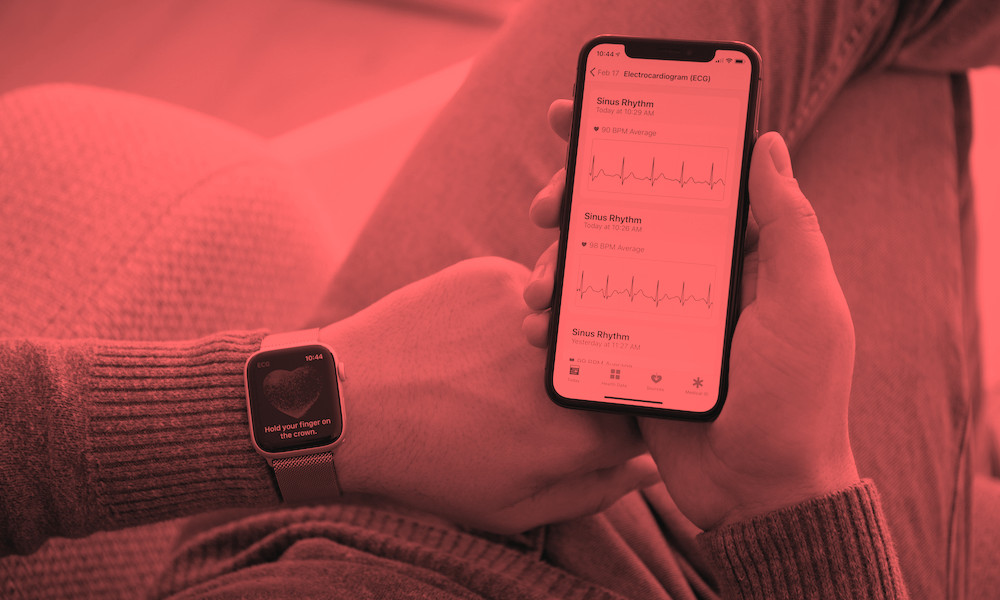Apple Watch May Reveal Long-Term Negative Effects of COVID-19, New Research Suggests
 Credit: DenPhotos / Shutterstock
Credit: DenPhotos / Shutterstock
Toggle Dark Mode
Many medical researchers over the past year have undertaken studies to determine if the health sensors in the Apple Watch can be used to detect early signs of COVID-19. With the pandemic looking like it’s in the rear-view mirror, however, scientists have now begun to consider how Apple’s popular wearable can be used to help users recover from the aftermath of COVID-19.
According to The New York Times, scientists from the Scripps Research Translational Institute in La Jolla, California, recently published the results of a trial that they ran throughout much of 2020 and into early 2021 that revealed that many people who tested positive for COVID-19 continued to suffer from physiological changes that lasted far longer than the virus itself did.
The results of the study, which was dubbed Digital Engagement and Tracking for Early Control and Treatment — or DETECT — were recently published in the JAMA Network Open journal, revealing that some people experienced COVID-19 symptoms for as long as six months after they no longer tested positive for the original virus. The study, which ran from March 25, 2020 until January 24, 2021, monitored the health status of more than 37,000 participants using the Apple Watch and other wearables such as Fitbit devices.
The original goal was similar to that of studies by Stanford University and New York’s Mount Sinai Health System, which was simply to determine if data from the Apple Watch and other wearables could provide more accurate detection of COVID-19 than simply relying solely on self-reported symptoms.
Much like the other studies, researchers quickly found that there was indeed a correlation between COVID-19 infection and physiological changes reported by the Apple Watch.
However, the DETECT group also found something that they didn’t expect — digging deeper into the data, it became apparent that the Apple Watch continued showing changes in heart rate, steps, and sleep long after the primary COVID-19 symptoms had passed.
As a result of these findings, the group commissioned a new study to look at a subset of 875 participants who had reported COVID-like symptoms such as a fever, cough, body aches, or respiratory issues. Of these, 234 had tested positive for COVID-19, while the rest were presumed to have non-COVID infections.
Wearable devices offer an ability for us to be able to monitor people unobtrusively over long periods of time to see in an objective way — how really has the virus affected them?
Dr. Robert Hirten, Icahn School of Medicine at Mount Sinai
While participants in both groups slept more, walked less, and showed higher resting heart rates after they got sick, the study shows that these changes were noticeably more pronounced in those who have tested positive for COVID-19.
- About nine days after participants with COVID-19 first reported symptoms, their heart rates dropped. This did not occur in those with other illnesses.
- Following this initial drop, however, the heart rate in those who had COVID-19 rose again — and remained elevated for months.
- It took 79 days, on average, for the resting heart rates of COVID-19 positive participants to return to normal, compared to only four days for those in the non-COVID group.
- Sleep and physical activity levels also took longer to return to baseline for those who had COVID-19 versus those with other ailments.
- Nearly 14 percent of those with COVID-19 had a heart rate that remained more than 5 beats per minute above normal for up to 133 days after infection. These participants also generally reported the worst symptoms during the acute phase of their illness.
It’s been known for some time that survivors of the novel coronavirus suffer lingering, longer-term health effects, but this is one of the first studies that’s actually been able to put some meaningful data behind the condition that’s become known as “long Covid.”
One takeaway from this study is the belief that the prolonged heart rate elevation could be a sign that COVID-19 actually disrupts the autonomous nervous system, which is responsible for regulating things like heart rate and other basic physiological processes.
This would also explain the heart palpitations and dizziness reported by many suffering from “long Covid,” which also includes symptoms such as brain fog, shortness of breath, headaches, depression, and chest pains.
We want to kind of do a better job of collecting long-term symptoms so we can compare the physiological changes that we’re seeing with symptoms that participants are actually experiencing. So this is really a preliminary study that opens up many other studies down the road.
Dr. Jennifer M. Radin, PhD, MPH, Scripps Research Translational Institute
The DETECT study will likely be only the first of a great deal more research that will leverage the Apple Watch to determine the nature of long Covid. In February, the National Institutes of Health committed $1.15 billion to study the condition over the next four years, and it’s clear that wearables are going to continue to play a crucial role in providing much-needed data on these types of long-term symptoms.






